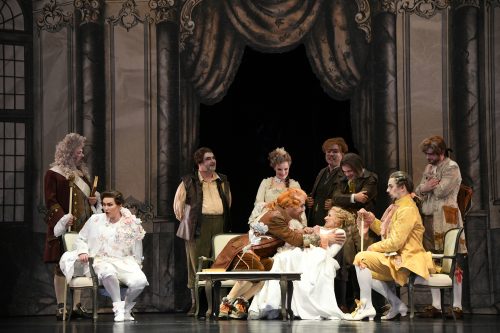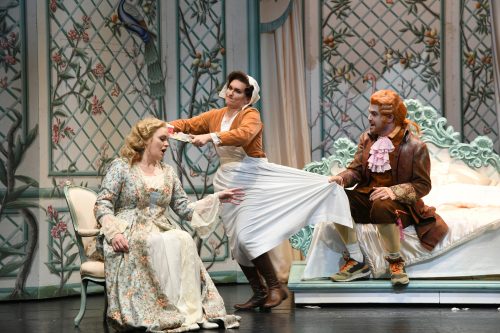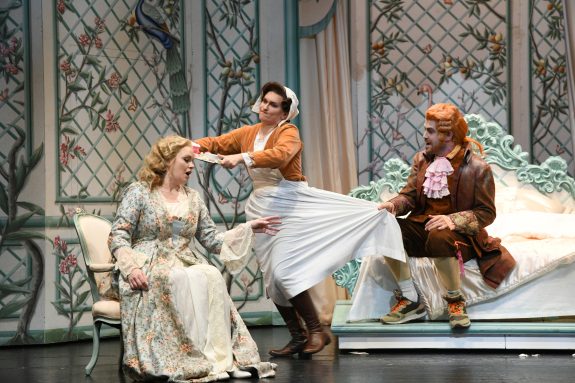 Germany Richard Strauss, Der Rosenkavalier: Soloists, Chorus, Children’s chorus, Extra chorus and Extras of Stadttheater Bremerhaven, Philharmonic Orchestra Bremerhaven / Marc Niemann (conductor). Stadttheater Bremerhaven, 4.5.2024. (DMD)
Germany Richard Strauss, Der Rosenkavalier: Soloists, Chorus, Children’s chorus, Extra chorus and Extras of Stadttheater Bremerhaven, Philharmonic Orchestra Bremerhaven / Marc Niemann (conductor). Stadttheater Bremerhaven, 4.5.2024. (DMD)

Striving to understand the world we live in has been a human characteristic across history and cultures. An important role of the arts has been to support this endeavour. That is why we, and the arts, have sought to provide narrative contexts for events in life. In some cases art has sought to represent life as we experience it without offering explanations. There is no causality, at best correlation. The plot, libretto and music of Der Rosenkavalier, taken together, represent a prime example of art mirroring life without seeking to superimpose a meaning-making frame. The nature of the work accounts for the complexity of what we see and hear from the orchestra pit and stage during a performance.
The Bremerhaven production of this opera must have taken such observations as its starting point. Together with consistent costume design and imaginative lighting, the framing devices that were there were presented as obvious and arbitrary. The set was inspired by Rococo designs, but the way it was realised suggested something fake: it looked like a paper cut-out, placed awkwardly on to the large stage, with clear views of the wings and stage machinery. The relatively small size of the acting space in relation to the available stage meant that the more private scenes were quite close to the ramp, making them – at least potentially – genuinely intimate, while the crowd scenes became intentionally cramped, with a brilliant choreography of chaos of people milling about in a rather hectic manner. The suggestion of a very lack of privacy for those private scenes was achieved through lighting effects allowing for shadows of people moving about to be seen through windows, for example.
Costumes were a mix of Rococo and contemporary, again suggesting the arbitrary nature of what we wear. The make-up highlighted the pale, powdered faces but also the hollow, red-rimmed eyes which revealed more of what lies beneath the powder in terms of the levels of personal hygiene that were appalling in earlier centuries compared with our current standards.
The framing device developed in this production came in the shape of a character the creative team added to the plot, Cupiderl (a diminutive form of the name Cupid, with an Austrian twist). This androgynous character, dressed in white, in a fat-suit with angelic wings, creating an absurd body shape with a protruding round belly, disappeared into the fly tower on metal wires at the start, invited the conductor to make his appearance and descended from on high to launch the applause for the curtain call. Cupiderl appeared again and again throughout the opera, becoming a familiar funny character, commenting silently on the action, but also exploring the stage, the entrance and exit doors to the backstage areas on the side of the stage, and interacting with members of the audience, all the while suggesting through gestures that what s/he saw was strangely both familiar (in an ‘oh dear, here they go again’ way) and strangely new (‘what on earth are they doing now?’). Laura Gabrielli made Cupiderl both funny and serious, happy and sad, knowing and ignorant, child-like and adult, combining clown-like aspects with touches of commedia dell’arte. The intended and very well-executed arbitrariness of Cupiderl’s character was the core of this production.
The music was of course part of that core. A conductor who seeks to unify the music Strauss composed for this opera faces an insurmountable challenge, simply because the unity here lies in its very diversity. Marc Niemann must have understood this, because he supported and led the exuberance of the action on stage, both in intimate and in crowded scenes, with the music: it celebrated the action. Nothing was intuitive but everything intended, everything composed and played for a very specific purpose. It was intentionally and demonstratively sweet in the intimate moments between the Marschallin and Octavian, or Octavian and Sophie. It was intentionally and demonstratively chaotic in the crowd scenes and brash to signal Ochs’s boorish manners. In all those and many more of the nuances, Niemann drew from the orchestra a sense and a sound of exuberance: the orchestra was celebrating the music and its own ability to render the music in the intended way.

Signe Heiberg as the Marschallin provided a consistent and beautiful combination of lyrical and dramatic singing. Her voice was rich, warm, velvety, golden. With Philipp Mayer, Ochs was presented as a younger man than in some other productions, even when he took off his wig at the end to comically reveal his bald head. Mayer was at ease with the role and delivered the operatic accent given to the character by librettist Hugo von Hofmannsthal with aplomb. His Ochs was above all selfish and uncaring. His comparatively lighter, bass-baritone voice matched the character’s age and outward appearance well. The voice was pleasant, used with a high level of musicality and well supported especially in the lower register. Boshana Milkov as Octavian has a secure higher register, but her voice radiates in the particularly beautiful lower register, for which this part offers plenty of passages. This made above all the duets and trios with the other female voices all the more impressive to listen to. Victoria Kunze brought her delightful, very nuanced and never repetitive energetic acting to the part of Sophie, very well matched indeed by the agility of the voice across the wide range of moods and emotions her character has to express. Marcin Hutek made Faninal more than a minor character with his energetic, clear baritone.
The minor characters were equally well acted and sung, by company members, guest artists or members of the chorus. The audience rewarded this remarkable overall achievement with standing ovations.
Daniel Meyer-Dinkgräfe
Production:
Director and Set design – Julius Theodor Semmelmann
Costumes – Carola Volles
Lighting – Thomas Güldenberg
Dramaturgy – Markus Tatzig
Chorus director – Mario El Fakih Hernández
Cast included:
The Marschallin – Signe Heiberg
Baron Ochs – Philipp Mayer
Octavian – Boshana Milkov
Herr von Faninal – Marcin Hutek
Sophie – Victoria Kunze
Marianne Leitmetzerin – Katharina Diegritz
Valzacchi – Andrew Irwin
Annina – Eva Maria Summerer
Police Officer – Róbert Tóth
The Marschallin’s Major-domo – MacKenzie Gallinger
Faninal’s Major-domo – MacKenzie Gallinger
Notary – Masahiro Yamada
Singer – Miloš Bulajić
Servant – James Bobby
Milliner – Iris Wemme-Baranowski
Vendor of Pets – Anton Kononchenko
Leopold – Mikolaj Fundela
Cupiderl – Laura Gabrielli
